Business Strategy Simulation Analysis
VerifiedAdded on 2020/05/28
|6
|1563
|369
AI Summary
This assignment presents an in-depth analysis of a business strategy simulation conducted over five years. The student outlines their chosen strategies, tracks key performance indicators like revenue, margins, and profitability, and compares their results to a competitor. The analysis highlights the importance of data-driven decision making, market responsiveness, and considering various financial aspects like pricing and advertising costs. Areas for improvement are identified, emphasizing the need for a more holistic approach to financial planning and utilizing advanced analytical techniques for optimal strategy development.
Contribute Materials
Your contribution can guide someone’s learning journey. Share your
documents today.
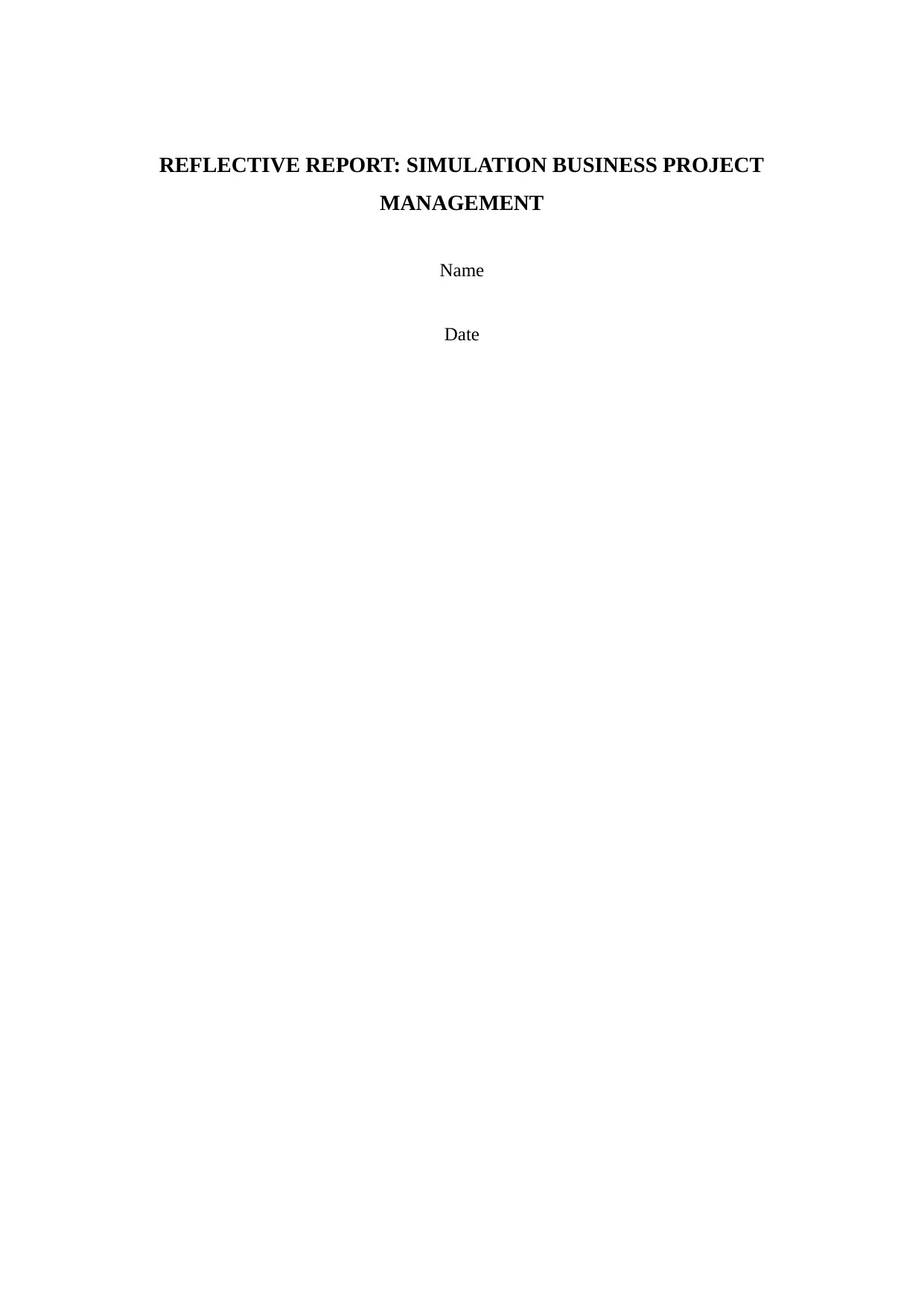
REFLECTIVE REPORT: SIMULATION BUSINESS PROJECT
MANAGEMENT
Name
Date
MANAGEMENT
Name
Date
Secure Best Marks with AI Grader
Need help grading? Try our AI Grader for instant feedback on your assignments.
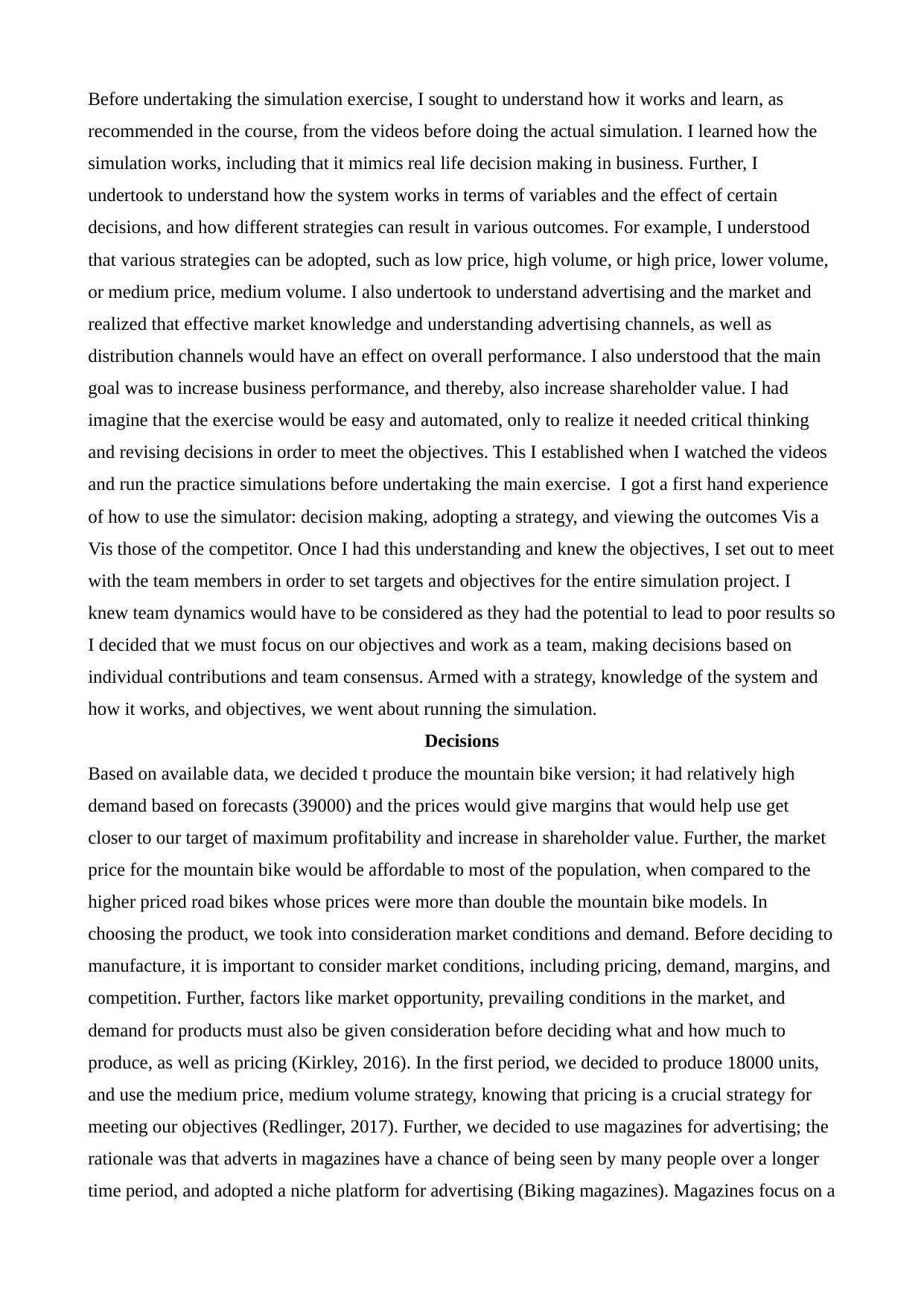
Before undertaking the simulation exercise, I sought to understand how it works and learn, as
recommended in the course, from the videos before doing the actual simulation. I learned how the
simulation works, including that it mimics real life decision making in business. Further, I
undertook to understand how the system works in terms of variables and the effect of certain
decisions, and how different strategies can result in various outcomes. For example, I understood
that various strategies can be adopted, such as low price, high volume, or high price, lower volume,
or medium price, medium volume. I also undertook to understand advertising and the market and
realized that effective market knowledge and understanding advertising channels, as well as
distribution channels would have an effect on overall performance. I also understood that the main
goal was to increase business performance, and thereby, also increase shareholder value. I had
imagine that the exercise would be easy and automated, only to realize it needed critical thinking
and revising decisions in order to meet the objectives. This I established when I watched the videos
and run the practice simulations before undertaking the main exercise. I got a first hand experience
of how to use the simulator: decision making, adopting a strategy, and viewing the outcomes Vis a
Vis those of the competitor. Once I had this understanding and knew the objectives, I set out to meet
with the team members in order to set targets and objectives for the entire simulation project. I
knew team dynamics would have to be considered as they had the potential to lead to poor results so
I decided that we must focus on our objectives and work as a team, making decisions based on
individual contributions and team consensus. Armed with a strategy, knowledge of the system and
how it works, and objectives, we went about running the simulation.
Decisions
Based on available data, we decided t produce the mountain bike version; it had relatively high
demand based on forecasts (39000) and the prices would give margins that would help use get
closer to our target of maximum profitability and increase in shareholder value. Further, the market
price for the mountain bike would be affordable to most of the population, when compared to the
higher priced road bikes whose prices were more than double the mountain bike models. In
choosing the product, we took into consideration market conditions and demand. Before deciding to
manufacture, it is important to consider market conditions, including pricing, demand, margins, and
competition. Further, factors like market opportunity, prevailing conditions in the market, and
demand for products must also be given consideration before deciding what and how much to
produce, as well as pricing (Kirkley, 2016). In the first period, we decided to produce 18000 units,
and use the medium price, medium volume strategy, knowing that pricing is a crucial strategy for
meeting our objectives (Redlinger, 2017). Further, we decided to use magazines for advertising; the
rationale was that adverts in magazines have a chance of being seen by many people over a longer
time period, and adopted a niche platform for advertising (Biking magazines). Magazines focus on a
recommended in the course, from the videos before doing the actual simulation. I learned how the
simulation works, including that it mimics real life decision making in business. Further, I
undertook to understand how the system works in terms of variables and the effect of certain
decisions, and how different strategies can result in various outcomes. For example, I understood
that various strategies can be adopted, such as low price, high volume, or high price, lower volume,
or medium price, medium volume. I also undertook to understand advertising and the market and
realized that effective market knowledge and understanding advertising channels, as well as
distribution channels would have an effect on overall performance. I also understood that the main
goal was to increase business performance, and thereby, also increase shareholder value. I had
imagine that the exercise would be easy and automated, only to realize it needed critical thinking
and revising decisions in order to meet the objectives. This I established when I watched the videos
and run the practice simulations before undertaking the main exercise. I got a first hand experience
of how to use the simulator: decision making, adopting a strategy, and viewing the outcomes Vis a
Vis those of the competitor. Once I had this understanding and knew the objectives, I set out to meet
with the team members in order to set targets and objectives for the entire simulation project. I
knew team dynamics would have to be considered as they had the potential to lead to poor results so
I decided that we must focus on our objectives and work as a team, making decisions based on
individual contributions and team consensus. Armed with a strategy, knowledge of the system and
how it works, and objectives, we went about running the simulation.
Decisions
Based on available data, we decided t produce the mountain bike version; it had relatively high
demand based on forecasts (39000) and the prices would give margins that would help use get
closer to our target of maximum profitability and increase in shareholder value. Further, the market
price for the mountain bike would be affordable to most of the population, when compared to the
higher priced road bikes whose prices were more than double the mountain bike models. In
choosing the product, we took into consideration market conditions and demand. Before deciding to
manufacture, it is important to consider market conditions, including pricing, demand, margins, and
competition. Further, factors like market opportunity, prevailing conditions in the market, and
demand for products must also be given consideration before deciding what and how much to
produce, as well as pricing (Kirkley, 2016). In the first period, we decided to produce 18000 units,
and use the medium price, medium volume strategy, knowing that pricing is a crucial strategy for
meeting our objectives (Redlinger, 2017). Further, we decided to use magazines for advertising; the
rationale was that adverts in magazines have a chance of being seen by many people over a longer
time period, and adopted a niche platform for advertising (Biking magazines). Magazines focus on a
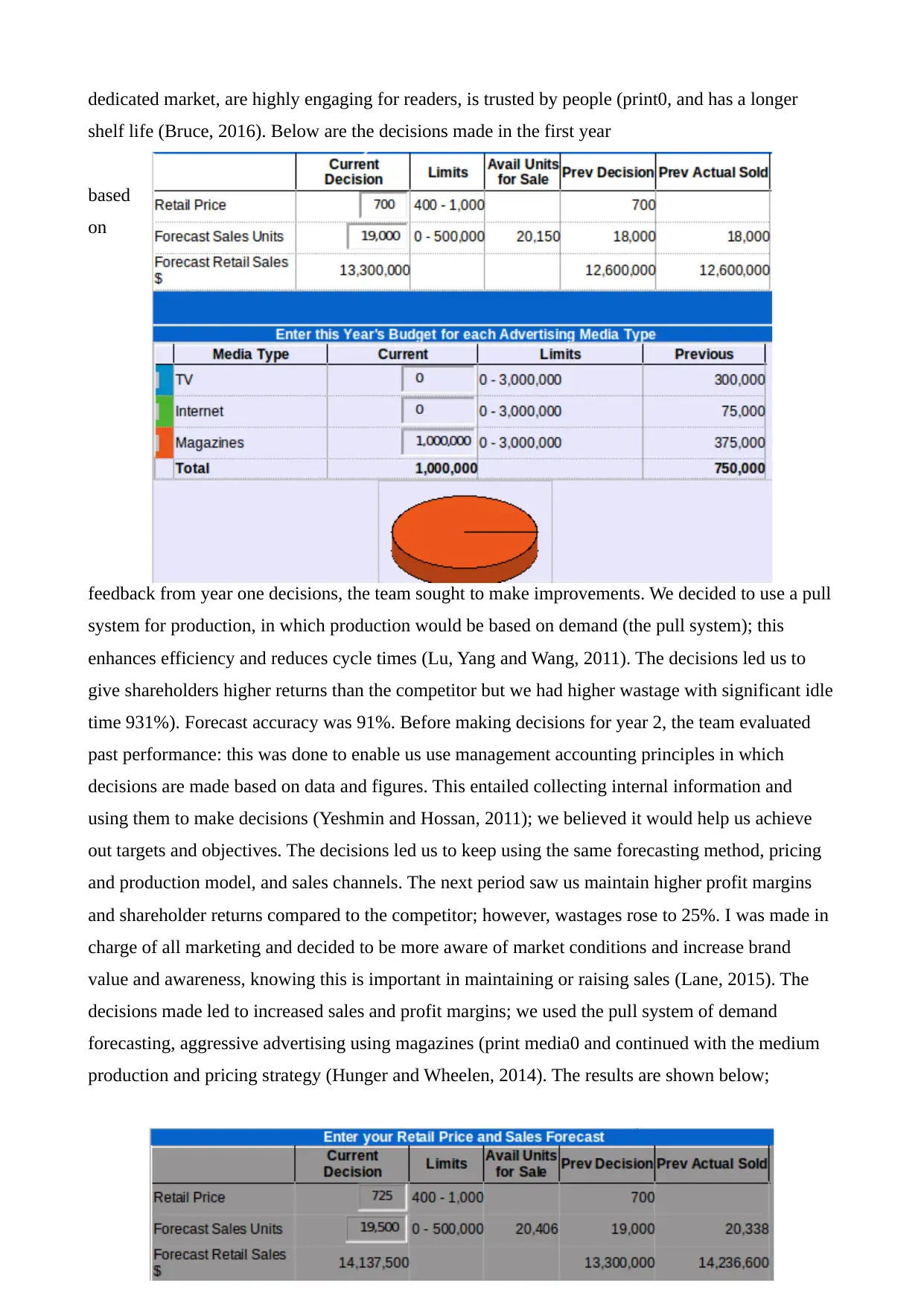
dedicated market, are highly engaging for readers, is trusted by people (print0, and has a longer
shelf life (Bruce, 2016). Below are the decisions made in the first year
based
on
feedback from year one decisions, the team sought to make improvements. We decided to use a pull
system for production, in which production would be based on demand (the pull system); this
enhances efficiency and reduces cycle times (Lu, Yang and Wang, 2011). The decisions led us to
give shareholders higher returns than the competitor but we had higher wastage with significant idle
time 931%). Forecast accuracy was 91%. Before making decisions for year 2, the team evaluated
past performance: this was done to enable us use management accounting principles in which
decisions are made based on data and figures. This entailed collecting internal information and
using them to make decisions (Yeshmin and Hossan, 2011); we believed it would help us achieve
out targets and objectives. The decisions led us to keep using the same forecasting method, pricing
and production model, and sales channels. The next period saw us maintain higher profit margins
and shareholder returns compared to the competitor; however, wastages rose to 25%. I was made in
charge of all marketing and decided to be more aware of market conditions and increase brand
value and awareness, knowing this is important in maintaining or raising sales (Lane, 2015). The
decisions made led to increased sales and profit margins; we used the pull system of demand
forecasting, aggressive advertising using magazines (print media0 and continued with the medium
production and pricing strategy (Hunger and Wheelen, 2014). The results are shown below;
shelf life (Bruce, 2016). Below are the decisions made in the first year
based
on
feedback from year one decisions, the team sought to make improvements. We decided to use a pull
system for production, in which production would be based on demand (the pull system); this
enhances efficiency and reduces cycle times (Lu, Yang and Wang, 2011). The decisions led us to
give shareholders higher returns than the competitor but we had higher wastage with significant idle
time 931%). Forecast accuracy was 91%. Before making decisions for year 2, the team evaluated
past performance: this was done to enable us use management accounting principles in which
decisions are made based on data and figures. This entailed collecting internal information and
using them to make decisions (Yeshmin and Hossan, 2011); we believed it would help us achieve
out targets and objectives. The decisions led us to keep using the same forecasting method, pricing
and production model, and sales channels. The next period saw us maintain higher profit margins
and shareholder returns compared to the competitor; however, wastages rose to 25%. I was made in
charge of all marketing and decided to be more aware of market conditions and increase brand
value and awareness, knowing this is important in maintaining or raising sales (Lane, 2015). The
decisions made led to increased sales and profit margins; we used the pull system of demand
forecasting, aggressive advertising using magazines (print media0 and continued with the medium
production and pricing strategy (Hunger and Wheelen, 2014). The results are shown below;
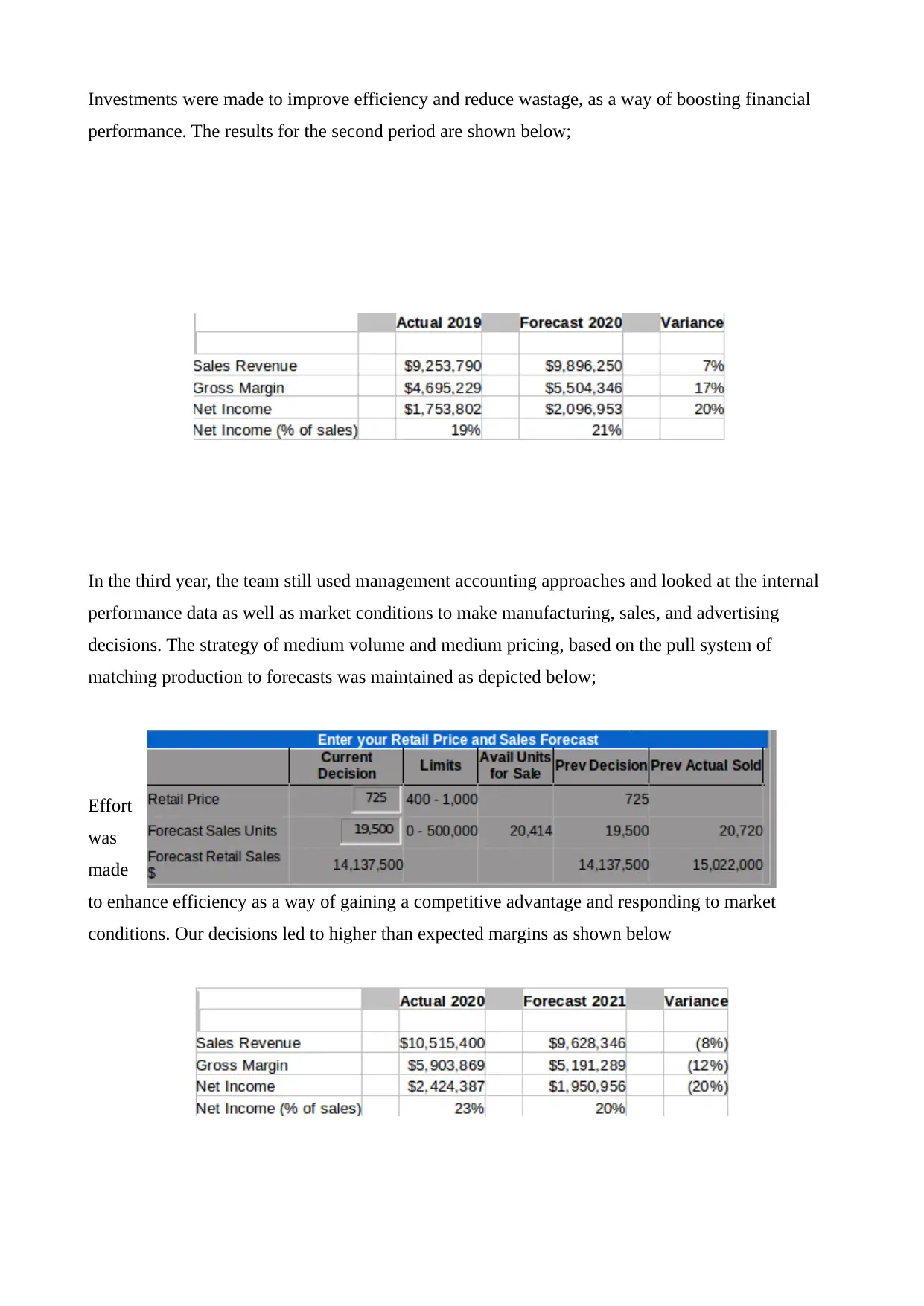
Investments were made to improve efficiency and reduce wastage, as a way of boosting financial
performance. The results for the second period are shown below;
In the third year, the team still used management accounting approaches and looked at the internal
performance data as well as market conditions to make manufacturing, sales, and advertising
decisions. The strategy of medium volume and medium pricing, based on the pull system of
matching production to forecasts was maintained as depicted below;
Effort
was
made
to enhance efficiency as a way of gaining a competitive advantage and responding to market
conditions. Our decisions led to higher than expected margins as shown below
performance. The results for the second period are shown below;
In the third year, the team still used management accounting approaches and looked at the internal
performance data as well as market conditions to make manufacturing, sales, and advertising
decisions. The strategy of medium volume and medium pricing, based on the pull system of
matching production to forecasts was maintained as depicted below;
Effort
was
made
to enhance efficiency as a way of gaining a competitive advantage and responding to market
conditions. Our decisions led to higher than expected margins as shown below
Secure Best Marks with AI Grader
Need help grading? Try our AI Grader for instant feedback on your assignments.
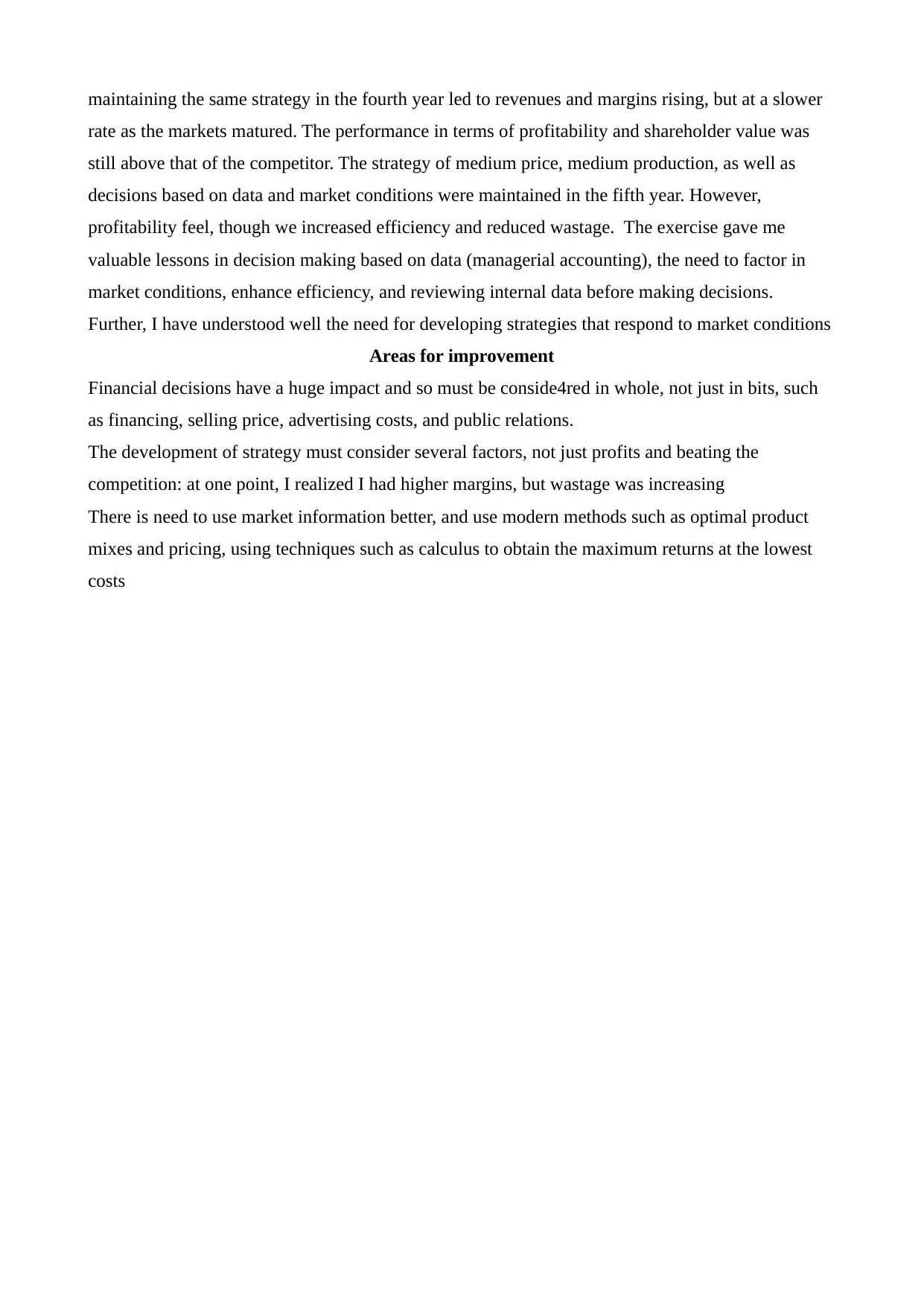
maintaining the same strategy in the fourth year led to revenues and margins rising, but at a slower
rate as the markets matured. The performance in terms of profitability and shareholder value was
still above that of the competitor. The strategy of medium price, medium production, as well as
decisions based on data and market conditions were maintained in the fifth year. However,
profitability feel, though we increased efficiency and reduced wastage. The exercise gave me
valuable lessons in decision making based on data (managerial accounting), the need to factor in
market conditions, enhance efficiency, and reviewing internal data before making decisions.
Further, I have understood well the need for developing strategies that respond to market conditions
Areas for improvement
Financial decisions have a huge impact and so must be conside4red in whole, not just in bits, such
as financing, selling price, advertising costs, and public relations.
The development of strategy must consider several factors, not just profits and beating the
competition: at one point, I realized I had higher margins, but wastage was increasing
There is need to use market information better, and use modern methods such as optimal product
mixes and pricing, using techniques such as calculus to obtain the maximum returns at the lowest
costs
rate as the markets matured. The performance in terms of profitability and shareholder value was
still above that of the competitor. The strategy of medium price, medium production, as well as
decisions based on data and market conditions were maintained in the fifth year. However,
profitability feel, though we increased efficiency and reduced wastage. The exercise gave me
valuable lessons in decision making based on data (managerial accounting), the need to factor in
market conditions, enhance efficiency, and reviewing internal data before making decisions.
Further, I have understood well the need for developing strategies that respond to market conditions
Areas for improvement
Financial decisions have a huge impact and so must be conside4red in whole, not just in bits, such
as financing, selling price, advertising costs, and public relations.
The development of strategy must consider several factors, not just profits and beating the
competition: at one point, I realized I had higher margins, but wastage was increasing
There is need to use market information better, and use modern methods such as optimal product
mixes and pricing, using techniques such as calculus to obtain the maximum returns at the lowest
costs
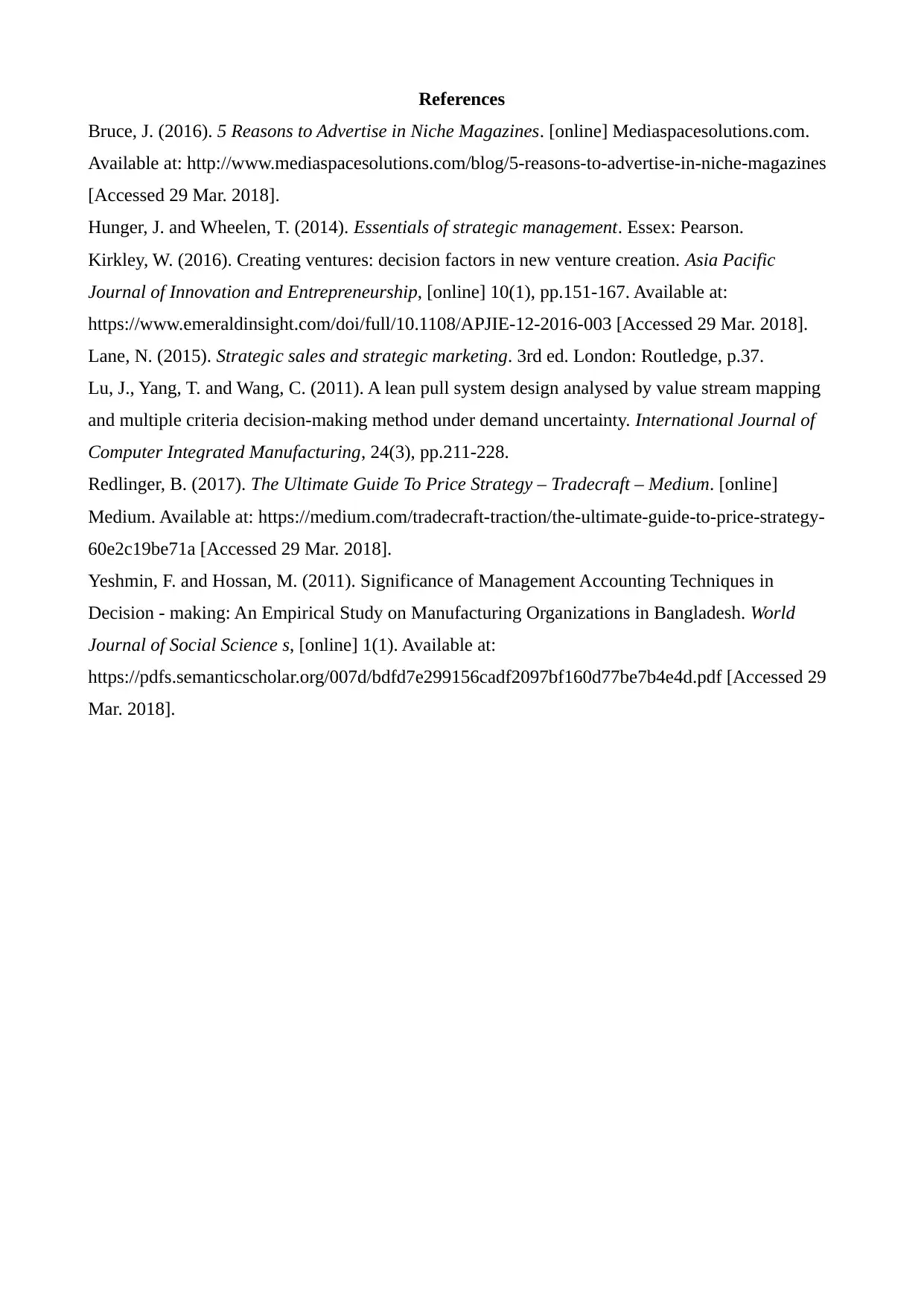
References
Bruce, J. (2016). 5 Reasons to Advertise in Niche Magazines. [online] Mediaspacesolutions.com.
Available at: http://www.mediaspacesolutions.com/blog/5-reasons-to-advertise-in-niche-magazines
[Accessed 29 Mar. 2018].
Hunger, J. and Wheelen, T. (2014). Essentials of strategic management. Essex: Pearson.
Kirkley, W. (2016). Creating ventures: decision factors in new venture creation. Asia Pacific
Journal of Innovation and Entrepreneurship, [online] 10(1), pp.151-167. Available at:
https://www.emeraldinsight.com/doi/full/10.1108/APJIE-12-2016-003 [Accessed 29 Mar. 2018].
Lane, N. (2015). Strategic sales and strategic marketing. 3rd ed. London: Routledge, p.37.
Lu, J., Yang, T. and Wang, C. (2011). A lean pull system design analysed by value stream mapping
and multiple criteria decision-making method under demand uncertainty. International Journal of
Computer Integrated Manufacturing, 24(3), pp.211-228.
Redlinger, B. (2017). The Ultimate Guide To Price Strategy – Tradecraft – Medium. [online]
Medium. Available at: https://medium.com/tradecraft-traction/the-ultimate-guide-to-price-strategy-
60e2c19be71a [Accessed 29 Mar. 2018].
Yeshmin, F. and Hossan, M. (2011). Significance of Management Accounting Techniques in
Decision - making: An Empirical Study on Manufacturing Organizations in Bangladesh. World
Journal of Social Science s, [online] 1(1). Available at:
https://pdfs.semanticscholar.org/007d/bdfd7e299156cadf2097bf160d77be7b4e4d.pdf [Accessed 29
Mar. 2018].
Bruce, J. (2016). 5 Reasons to Advertise in Niche Magazines. [online] Mediaspacesolutions.com.
Available at: http://www.mediaspacesolutions.com/blog/5-reasons-to-advertise-in-niche-magazines
[Accessed 29 Mar. 2018].
Hunger, J. and Wheelen, T. (2014). Essentials of strategic management. Essex: Pearson.
Kirkley, W. (2016). Creating ventures: decision factors in new venture creation. Asia Pacific
Journal of Innovation and Entrepreneurship, [online] 10(1), pp.151-167. Available at:
https://www.emeraldinsight.com/doi/full/10.1108/APJIE-12-2016-003 [Accessed 29 Mar. 2018].
Lane, N. (2015). Strategic sales and strategic marketing. 3rd ed. London: Routledge, p.37.
Lu, J., Yang, T. and Wang, C. (2011). A lean pull system design analysed by value stream mapping
and multiple criteria decision-making method under demand uncertainty. International Journal of
Computer Integrated Manufacturing, 24(3), pp.211-228.
Redlinger, B. (2017). The Ultimate Guide To Price Strategy – Tradecraft – Medium. [online]
Medium. Available at: https://medium.com/tradecraft-traction/the-ultimate-guide-to-price-strategy-
60e2c19be71a [Accessed 29 Mar. 2018].
Yeshmin, F. and Hossan, M. (2011). Significance of Management Accounting Techniques in
Decision - making: An Empirical Study on Manufacturing Organizations in Bangladesh. World
Journal of Social Science s, [online] 1(1). Available at:
https://pdfs.semanticscholar.org/007d/bdfd7e299156cadf2097bf160d77be7b4e4d.pdf [Accessed 29
Mar. 2018].
1 out of 6
Related Documents
Your All-in-One AI-Powered Toolkit for Academic Success.
+13062052269
info@desklib.com
Available 24*7 on WhatsApp / Email
![[object Object]](/_next/static/media/star-bottom.7253800d.svg)
Unlock your academic potential
© 2024 | Zucol Services PVT LTD | All rights reserved.





